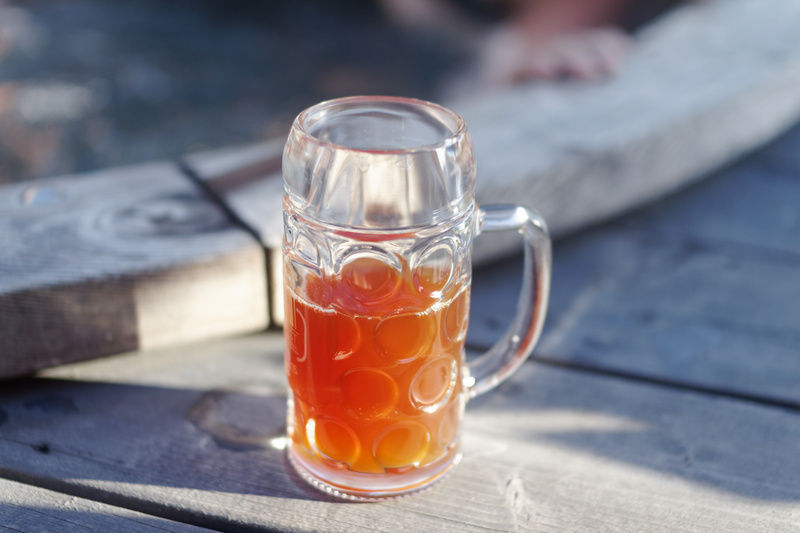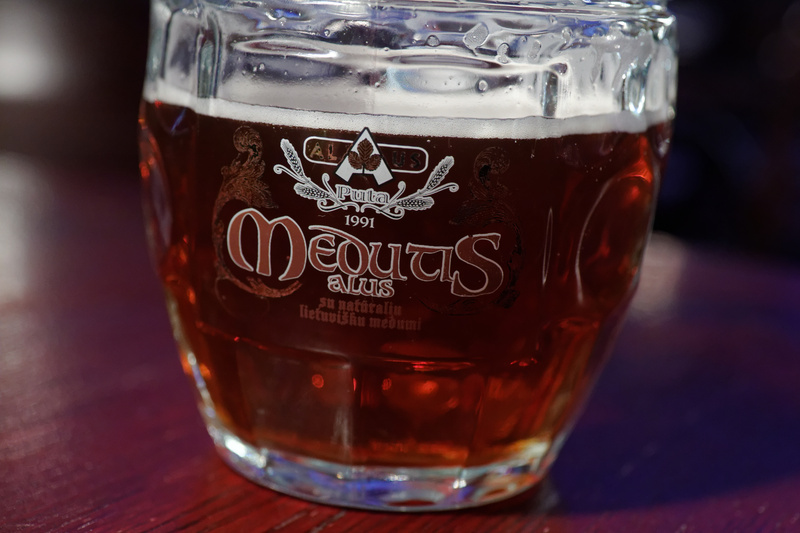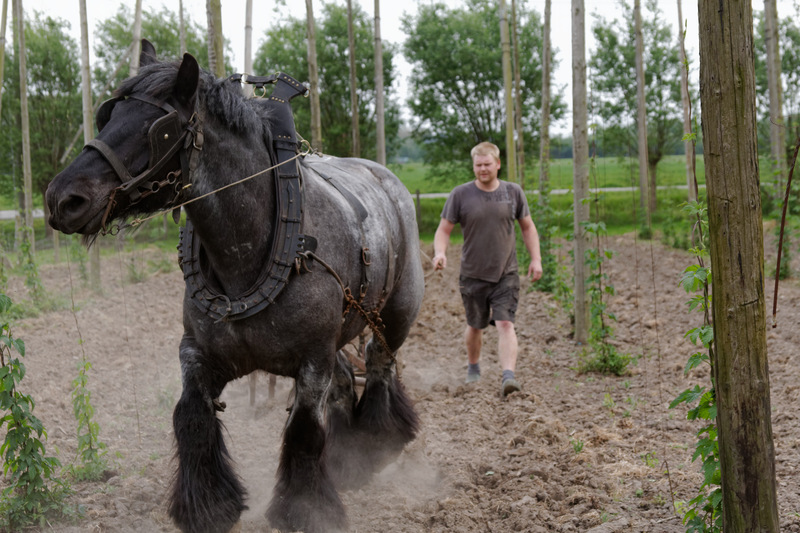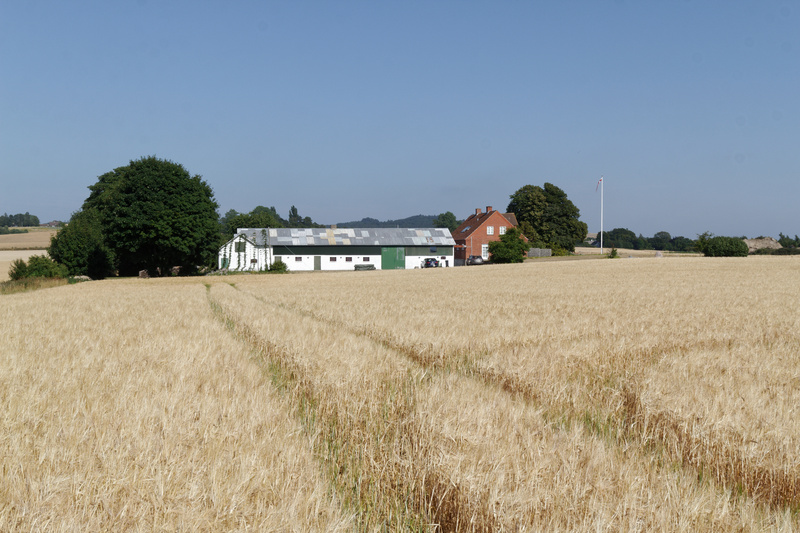What counts as a farmhouse ale?

Mug of sahti, Finnish farmhouse ale, brewed with hot rocks |
The most common question I get in interviews is "what do you consider to be a farmhouse ale?" and since the answer is a little involved I decided to write it up more fully. There is a fairly clear-cut definition, but it takes a little explaining.
The original farmhouse ales
This was pretty simple back in the old days, before the modernization of agriculture, completely changed life in the countryside, and the traditional brewing with it. Farmhouse ale was beer brewed on the farm, from the farm's own grain, for the people on the farm.
The great transformation of the countryside transitioned the farms from subsistence agriculture, where you eat what you grow, to growing products for sale. Many farmers switched from mainly growing grain to growing fruit, dairy farming, or other products. And eventually most people stopped being farmers at all.
These people had to start buying grain, and later they even started buying malt, which strictly speaking made them home brewers. But modern home brewers brew commercial styles. These home brewers kept brewing the traditional beer in their region, using the traditional ingredients and often the farmhouse yeast, using the traditional equipment. They also remained in the traditional mindset, brewing only one style of beer, and relying on methods taught by participation and observation instead of learning from books.

Tore Jan Ramsøy moving the mash to the lauter tun. Ulvik, Hardanger. |
Today's farmhouse ales
Today, nearly all the farmhouse brewers are economically speaking home brewers, but I still consider them farmhouse brewers because in every other respect they are continuing their local brewing tradition. The beer definitely tastes farmhouse ale, and not modern beer. This definition doesn't make a 100% sharp black-or-white distinction, but in practice I find it works.
In Hardanger, western Norway, I met two brewers who expressed skepticism about traditional brewing. The main brewer was Danish and had learned to brew in Denmark, while his friend came from an area in western Norway where the brewing had died before he was born. Their beer tasted of US west coast hops, but had low carbonation. And they brewed in a traditional-like brewhouse, using juniper branches, brewing 150-liter batches like farmhouse brewers, and even used a traditional lauter tun. But they used Protaflocc to clear the beer.
To me they have to be considered hybrid brewers. They were clearly influenced both by modern home brewing, but also by the local tradition.

Glass of commercial farmhouse ale at Alaus Namai in Vilnius. |
Commercial farmhouse brewers
But what about commercial farmhouse breweries?
There are people who grew up in the farmhouse brewing tradition who have started commercial breweries producing the same kinds of beers their parents and neighbours made. Their brewkit is usually specially designed to produce the local farmhouse style. These are obviously farmhouse breweries, whether they are located on a farm or not.
Examples: Pihtla in Estonia (both of them), Jovaru Alus, Piniavos, Su Puta, Ramunas Čižas, and more in Lithuania. Also several breweries in Finland.

Voss Bryggeri in Voss. |
Craft breweries
It gets more complicated with a brewery like Voss Bryggeri. One of the founders was a farmhouse brewer in Voss for decades before starting the brewery, but on the other hand they made only modern styles the first few years. Nearly all their brewers have been people with no prior connection to farmhouse brewing who have moved to Voss. And yet they do make a beer they call Vossaøl, with the correct ingredients and the closest approximation to the traditional process that they can achieve with the brewing equipment they have. One local farmhouse brewer described the beer as "the closest thing to Vossaøl you can get into a can."
My conclusion is that while Voss Bryggeri is not really a farmhouse brewery, that beer has to be accepted as if not 100% true farmhouse ale, then something very close to it.
When someone outside the farmhouse brewing region tries to make a traditional farmhouse ale with the correct ingredients and process and produce something that tastes close to the original, then to me that's a replica of a farmhouse ale. And if someone were to skip the phrase "replica of" and just call it a farmhouse ale I wouldn't really complain.
There are of course many breweries that call themselves "farmhouse breweries" on various grounds. For example because the brewery is on a farm. To me that's not a farmhouse brewery. If it were, we'd have to also introduce industrial estate breweries and railway arch breweries as categories. These categories make no sense, because the location has nothing to do with the beer. You can't taste what kind of location the brewery is in.
Some use local farm products in the beer, like hops or fruit. Or they harvested a yeast nearby. Again, to me that has nothing to do with farmhouse brewing. If they grew the grain and malted it themselves I suppose it could be called neo-farmhouse, or something like that, but the essence of farmhouse brewing is the tradition that links the brewer with past brewers in the same area. Anyone who brews modern styles is working in essentially the same tradition as, say, Brewdog, Fuller's, and Carlsberg. Farmhouse brewing is about the tradition, not the source of the ingredients.

Ploughing the hop field to keep the weeds down. Belgium. |
Saison: farmhouse or not?
Which brings us to perhaps the trickiest case of all: the brewers of saison and biére de garde. To me the test is: are the beers they make today replicas of what the farmers in those areas used to brew from their own grain? Are they still working in the same tradition? Getting a definitive answer to that is surprisingly difficult.
Phil Markowski's foundational book, Farmhouse ales, contains a historical essay on saison by Yvan de Baets which claims the current saisons are like the historical farmhouse ales. The basis is partly tastings he personally conducted of old saisons, which would demonstrate a link with the early 20th century, but those were still commercially brewed beers. He also cites two brewing books, published 1946 and 1871, but it's not clear from his text exactly what the link is, nor what types of beers are being linked.
Roel Mulder took exception to this presentation and did a thorough blog post walking through the evidence as far as he knew it. A key point for him is that De Baets's sources do not describe farmers brewing from their own grain. Further, De Baets claims saison was originally brewed at the start of winter and stored through winter, spring, and summer to be consumed during the heavy harvest work at the end of summer. De Baets says the beer was stored through the summer because brewing during the summer "was almost out of the question" (p96). Mulder takes exception to this, too, because he found records of commercial saison breweries brewing in the summer.
Personally, I think De Baets is very likely right that saison got its name from a seasonal beer intended for harvest workers on the farm. And it's also very likely true that the current Belgian saison breweries have a link with this tradition. How close that connection is I cannot judge, although from what research has been published so far it seems that it might be possible to do a comparison.
Brewing beer for either haymaking or the grain harvest was extremely common in the farmhouse brewing regions in general, and the practice is overwhelmingly documented. I've summarized that evidence on pages 176-177 in my book.

Nøddebjerggaard farm on Møn in Denmark used to brew gammeltøl. |
In Denmark it was very common to brew a strong beer in February-April and store it until the heavy summer fieldwork. I haven't done the work yet to see if it was for the haymaking or for the grain harvest, but the principle is the same. This beer was called "gammeltøl" (old beer). (My book, p296.)
In Westphalia in Germany, a little over 250km from Hainaut, there was also a tradition for brewing beer in March that was drunk during the heavy summer fieldwork. (My book, p340.) A curious detail is that two accounts say the beer is similar to commercial altbier, which, strangely, is the same name as the Danish gammeltøl. Nobody seems to refer to the farmhouse ale as altbier, though.
So while I can't prove that farmers in Hainaut brewed beer in spring for the harvest work it would not be at all surprising if they did. I see no reason to doubt De Baets on this point.
Mulder makes a point out of Wallonia being one of the most industrialized regions in Europe, which on the face of it sounds like a strong argument against farmhouse brewing. But the brewers in Westphalia were just north of the Ruhr valley, perhaps the densest agglomeration of industry in all of Europe, yet the farmers brewed into the 1950s in some places.
Farmers who grow grain will brew beer as long as it makes economic sense for them, and whether there is industry nearby won't necessarily affect the economic logic at all.

Danish farm on north Zealand. |
The brewing of saison shows a farmhouse signature on another point, too: the pitch temperature. Dupont pitches at very high temperatures, which is characteristic of farmhouse brewing everywhere. Again I think it's more likely than not that there is a link between today's saison brewers and the farmhouse brewers. I haven't seen any research actually demonstrating that link so thoroughly as to put it beyond challenge, but in his rebuttal to Mulder De Baets points to a possible starting point for doing that:
In the 18th and the 19th Centuries, you had plenty of farming treatises being published. In most if not all of them you have a chapter on brewing. And not only homebrewing (for the family), but also sometimes at a level allowing the making of beer for a larger amount of people (the saisonniers, or summer workers for instance, and most probably some folks of the village).
If these manuals describe brewing similar to present-day saison you would have a very convincing case for the link.
Anyway, to cut a long story short, personally I see no reason not to accept that saison is beer style in the farmhouse family, even though it may have changed somewhat over the years. For example, I would be very surprised if the farmers brewed a carbonated beer.
Similar posts
Understanding farmhouse ale
Somehow, the idea that farmhouse ale is a style of beer that began in "France and Belgium in the late 19th and early 20th centuries" has gotten traction
Read | 2015-03-10 19:08
Interview with Simonas Gutautas of Dundulis
During my last trip to Lithuania I met Simonas Gutautas, who works for the Dundulis brewery
Read | 2015-05-11 14:12
Farmhouse ales of Europe
Having surveyed the state of farmhouse brewing in Norway it's time to look at the same thing in Europe generally
Read | 2014-10-18 16:46
Comments
Roel Mulder - 2020-07-26 15:06:11
Hi Lars,
Nice post and I'm honoured that I get a name check. I'll make a few remarks to clarify my point of view. You may do with this as you like.
You say, '...saison got its name from a seasonal beer intended for harvest workers on the farm.': There's is no evidence for this. Saison is first mentioned in Liège and throughout the 19th century it was seen as a beer style typical to the city of Liège. Indeed saison takes its name from the season it was brewed, but initially the intended drinkers were more likely to be city folk than farm workers.
Sure enough, there's evidence that Belgian farmers brewed beer for their own consumption in the 19th century (see https://lostbeers.com/the-real-belgian-farmhouse-ales/ ). Some farmers also combined their farm with a small commercial brewery. Some breweries still extant have their roots in a farm (Palm, Bosteels, Bavik, De Ryck, even Alken-Maes...). Did Belgian farmers drink their own beer at harvest time? Probably many of them did. Others bought their beer at commercial breweries. For instance, around 1900 in Western Flanders brewers noted that old brown beer was very popular among farmers at harvest time.
However, there's no contemporary evidence that Belgian farm beers were specifically called saison. Instead, saison was reserved for very different, non-farmhouse beers. In the 19th century it was known as a city beer, mainly in Liège, after the First World War it gained popularity in Hainaut were it was advertised as a beer matured in cellars at commercial breweries.
The 'saison is farmhouse beer' story only surfaced in the 1980's, at Dupont. Probably, at Dupont and the immediate surroundings, saison had indeed been a name for a beer sold to farmers in the early 20th century. Because Dupont was among the last breweries to still produce saison, it was their farm story that was erroneously taken to represent saison history as a whole.
Then, as I noted, in 2004 Yvan de Baets wrote his own version of saison history that was a brave but doomed attempt at reconciling the very local Dupont saison story to the overwhelming evidence that nationwide, saison actually had been something very different.
So, yo put your questions to the test: are the beers they make today replicas of what the farmers in those areas used to brew from their own grain? Are they still working in the same tradition?
I think that for Belgium the answer is: we know extremely little about actual non-commercial Belgian farmhouse brewing in the past, certainly not about farmers brewing 'with their own grain'. Are there still breweries in Belgium working in a farmhouse tradition? That would depend on your definition. Even the most old-fashioned Belgian breweries are miles away from what farmers were doing in, say, the early 19th century. Even Dupont was already using a steam engine as early as 1867.
To me, today's Belgian saison is the outcome of many developments in commercial brewing and technical innovation, in which farming plays a very minor role, if at all. If saison tastes funky, it's because of the way Belgian commercial brewing culture has worked, the same creative and sometimes very ideosyncratic Belgian commercial brewing culture that gave us Rodenbach, lambic and trappist beers.
Lars Marius Garshol - 2020-07-26 15:21:43
Thanks for commenting, Roel!
I think we mostly agree, and the differences are mainly over nuances.
Note that I don't say saison was a seasonal farm beer (because I don't know that), but I think probably De Baets is right to say so. Probably.
I'm aware there is no direct evidence, but that's not enough to prove that Dupoint has simply made the story up. I think it fits too well with accounts from other places (Denmark and Westphalia, for example) for that to be likely. The same thing was done in Lithuania, btw, so it seems to have been custom over a very large area.
I think if you want to argue that the story is false you need to do something more than simply point to an absence of hard evidence.
I don't understand why it matters that saison de Liége was something different. If it was different it's a different beer with a different story, right? That it happens to have the same name doesn't tell us anything about saison from Hainaut.
I agree we know far too little about Belgian farmhouse ale on the farms, and that that's the main thing that makes this issue so tricky. But there are sources that could tell us about these beers. De Baets pointed to one group, and you in your blog posts pointed to another possible group. So there's work left to do here...
I'm not sure it matters that Dupont had a steam engine. All of those commercial farmhouse breweries I pointed to above use electricity and steel to brew their beers now, but you can still find extremely direct connections between the farm beers and the beers they make now. The beers are not the same as they were, but clearly brewed in the same tradition and not hugely different from what they used to be.
Isn't the reason that saison is funky because the yeast belongs to the Beer 2 group? Meaning, it's funky because they're still using the same yeast and that yeast was always funky.
Robert - 2020-07-27 09:17:06
I really wanted to read this, but I just couldn't follow along due to all of the grammatical errors. Please, do yourself a favor and hire an editor that proofs and corrects.
Also Robert - 2020-07-27 10:00:59
Are you okay Robert? I found this article very clear and easy to understand.
Lars, I've followed your blog for a while now and am always impressed by your well thought out arguments. I suppose it's hard to get any definitive answers, but I think looking at general trends is a useful viewpoint when considering traditional brewing practices. Changes happen slowly in traditional practices, but good ideas spread relatively quickly.
Cheers
Rob
Matt Spaanem - 2020-07-29 14:37:10
Hi Lars,
Excellent article as always. Something struck me reading that that I now wonder why I never really questioned before. Do you know why the German brewers brewed specifically in March for their keeping beer? That doesn't really line up with any sort of harvest or anything. Sure harvest time is busy and beer ingredients keep but why not brew in January or something when there's nothing going on? Any ideas?
Thanks, Matt
Jeff - 2020-07-29 14:54:33
Hi Lars, Another great piece to read from you! I’ve been a fan of your blog for years and really really love your latest book! My wife and I own an extremely small brewery in the United States where we make modern and traditional style beers. Inspired by you and Mika Laitinen, we have delved into Eastern European farmhouse styles. Our focus on this series of beers is using traditional equipment and techniques, but only very local ingredients (other than the yeast which I have harvested and reuse.) Once we really get going with those beers we wanted them to be labeled as Eastern Washington Farmhouse Ales. After reading this, I think that would be inappropriate. I would appreciate any feedback or suggestions you might have for the series (so far we plan to make Sahti, Vossaøl, Gotlandsricke, Koduõlu and hopefully Keptinis in the old oven house on our property)! We’re wanting to honor these styles, and introduce them to our customers, but don’t want to be insensitive or offensive by doing this. Anyway, would love to hear your thoughts. Our place is Precious Things Fermentation Project and you find us on Facebook and Instagram @preciousthingsbeer Cheers! -Jeff
Lars Marius Garshol - 2020-07-29 17:18:07
@Matt: Thanks! And good question. I don't really know why the Germans (and Danes) chose March. It may be that they brewed as late as possible before the snow melted and the busy times began, so that the beer didn't have to keep any longer than necessary. But that's just a guess.
Lars Marius Garshol - 2020-07-29 17:22:18
@Jeff: Thank you! I agree describing these as "Eastern Washington Farmhouse Ales" would be a bit odd, given that the inspirations are all from completely different regions. You could call them "Farmhouse Ale Replicas from Eastern Washington" or something? "European Farmhouse Ales from Eastern Washington"?
Anyway, I hope you do brew that series. Sounds very cool! Wish I could go there and try them.
Roar - 2020-07-29 20:35:54
@Matt My guess is that it is simply temperature related. The climate has changed at lot during the thousands of years beer have been brewed across Europe, but still. Fermentation was by no doubt less risky early spring than during winter. Cellars not affected by temperature was not common in Northern Europe (assumption) I live in the middle part of Norway and there is a lot of old stories of the yeast not “working” and the shame it brought on the farm. This is obviously not only temperature related but it might be a big one.:
Brewerscoop@gmail.com arms - 2020-07-31 07:07:33
Who gives a shit what it is called as long as it tastes good
Samson Ullinger - 2020-08-04 01:25:46
Hi Lars
My name is Samson Ullinger, I am an Australian homebrewer. I was wondering if you could give me any advice on interviewing people about traditional brewing. My Godfather spent some time in Orkney working at a distillery. He tasted some farmhouse ales in the region and may have been involved in making some and I would like to interview him on the subject. Interestingly he described the yeast used at the distillery as being extremely similar to Voss Kveik (Which he tasted from a beer I made with it). He is a professional wine taster and has had a lot of experience with beer so I think he could be a valuable source on the subject. I also live in a community where there are multiple traditional ethiopian brewers and would enjoy the opportunity to document their beers. (I would have sent this via email but I could not find one)
Lars Marius Garshol - 2020-08-07 14:19:05
Hi Samson. I've sent you an email. Check your spam if you don't see it.
Clodoaldo de Oliveira - 2020-08-08 15:35:16
Excelente artigo como sempre, obrigado por compartilhar suas idéias, cervejas, viagens e conhecimeto, fiz a receita do Keptinis, ficou uma cerveja boa.
Abraço direto do Brasil, Maquinista Clodoaldo.
Alfred Anheier - 2020-10-26 23:49:29
Hi Lars.
Just read with relish your book on historical brewing techniques. As a German living in the US, using ultrafancy equipment (by your standards, I am sure), a PicoBrew Z1, I am intrigued as to the infatuation with methods which are ultimately doomed to extinction. Don't get me wrong, I like my beer to be flavourful, but I also live in a century where I can't grow/malt my own grain unless I live on a farm (I do not), and most of the processes used are out of my grasp.
However, I can use my equipment to brew in its style, as I found, to my surprise, a juniper tree in my front yard. Not Communis, but useable. Planning on an infusion, then using the brewwater.
From your tasting experiences, how much does a high alpha hops collide with the juniper flavour, stipulating that there are many factors that are hard to reconcile?
Lars Marius Garshol - 2020-10-27 07:19:25
We'll see if the methods are actually doomed to extinction.
In my experience high alpha hops don't really collide with the juniper. There have been some quite successful juniper IPAs. But both contribute bitterness, so you need to be careful that the sum of the two doesn't make the beer too bitter.